|
|
1-Port ISDN-BRI WAN Interface Card Configuration Note
Product Numbers:
WIC36-1B-S/T, WIC36-1B-U, CPAWIC36-1B-S/T, CPAWIC36-1B-U
This document provides information about the following Integrated Services Digital Network-Basic Rate Interface (ISDN-BRI) WAN interface cards for the Cisco 3600 series of modular access routers:
Unless specifically identified, references to BRI WAN interface cards in this configuration note include both cards.
Figure 1 : 1-Port ISDN-BRI WAN Interface Card (S/T Interface)
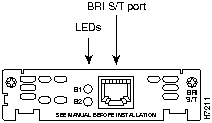
Figure 2 : 1-Port ISDN-BRI with NT1 WAN Interface Card (U Interface)
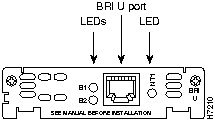
A BRI WAN interface card fits into a network module that has slots for WAN cards (called a 2-slot network module or base module). The network module installs in turn into the router chassis. You cannot install a WAN interface card directly into the router chassis.
Use this document in conjunction with your router installation and configuration guide and the Regulatory Compliance and Safety Information document for your router. If you have questions or need help, refer to the section "Obtaining Service and Support" later in this document for further information.
This document contains the following sections:
![]()
Follow these guidelines to ensure general safety:
Follow these guidelines when working on equipment powered by electricity:
Preventing Electrostatic Discharge Damage
Electrostatic discharge (ESD) can damage equipment and impair electrical circuitry. It occurs when electronic printed circuit cards are improperly handled and can result in complete or intermittent failures. Always follow ESD prevention procedures when removing and replacing cards. Ensure that the router chassis is electrically connected to earth ground. Wear an ESD-preventive wrist strap, ensuring that it makes good skin contact. Connect the clip to an unpainted surface of the chassis frame to safely channel unwanted ESD voltages to ground. To properly guard against ESD damage and shocks, the wrist strap and cord must operate effectively. If no wrist strap is available, ground yourself by touching the metal part of the chassis.
You need the following tools and equipment to install a WAN interface card in a Cisco 3600 series router:
WAN Interface Card Slot Assignments
A 2-slot network module for Cisco 3600 series routers has two slots for installing WAN interface cards. These slots are numbered W0, on the right, and W1, on the left. Some WAN interface cards are keyed to be installed in slot W1 only. Cards that do not have a key fit into either slot.
Both BRI WAN interface cards have a key and fit into slot W1 only.
The BRI S/T WAN interface card includes two termination jumpers, labeled J1 and J2. (See Figure 3.) Before installing this card, make sure that these jumpers are set correctly for your installation.
The jumpers are factory-configured in the B position (100 ohms termination). Keep the jumpers in this position to use the BRI S/T WAN interface card in a point-to-point connection or as the last device on the line of a passive-bus connection. Set the termination jumpers to the A position to use the BRI S/T WAN interface card in a passive-bus connection where it is not the last device on the line.
Figure 3 : Termination Jumpers on the BRI S/T WAN Interface Card
Installing a BRI WAN Interface Card in a Router
The following instructions apply only to installing a WAN interface card in a 2-slot network module. If you need to install the 2-slot module in a chassis slot, see your router installation and configuration guide.
You can install WAN interface cards either before or after mounting the router, whichever is more convenient. You can install the card in the base module either before or after installing the base module in the router chassis.
Follow this procedure to install the WAN interface card in the 2-slot network module:
Figure 4 : Installing a BRI WAN Interface Card in a 2-Slot Network Module
Blank WAN Interface Card Panels
If the 2-slot network module is configured with fewer than two WAN interface cards, make sure that blank panels fill the open base module slots to provide proper airflow. (See Figure 5.)
Figure 5 : Blank WAN Interface Card Panel
Connecting the WAN Interface Card to the Network
After you install the BRI WAN interface card in the WAN card slot network module and install the network module in the router, use the appropriate cable to connect the BRI card to your WAN.
To connect a BRI S/T WAN interface card, use a straight-through RJ-45-to-RJ-45 cable to connect the card's RJ-45 connector to an NT1 device. (See Figure 6.)
To connect a BRI U WAN interface card, connect a straight-through RJ-45-to-RJ-45 cable directly to your ISDN outlet. (See Figure 7.)
Figure 6 : Connecting a BRI S/T WAN Interface Card to an NT1
Figure 7 : Connecting a BRI U WAN Interface Card to an ISDN Outlet
Table 1 shows the pinout for the BRI RJ-45 connector.
Table 1 : BRI Port Pinout (RJ-45)
BRI S/T WAN interface cards have two LEDs. These LEDs indicate call activity on the two ISDN-BRI B-channels, as listed in Table 2.
Table 2 : BRI S/T WAN Interface Card LEDs
Figure 8 shows the BRI S/T WAN interface card.
Figure 8 : 1-Port ISDN-BRI WAN Interface Card (S/T Interface)
BRI U WAN interface cards have three LEDs. Two of these LEDs indicate call activity on the two ISDN-BRI B-channels, as listed in Table 3. The third LED, labeled NT1, indicates synchronization status of the NT1.
Table 3 : BRI U WAN Interface Card LEDs
Figure 9 shows the BRI U WAN interface card.
Figure 9 : 1-Port ISDN-BRI with NT1 WAN Interface Card (U Interface)
Whenever you install a new WAN interface card, or if you want to change the configuration of an existing interface, you must configure the interface. If you replace a card that was already configured, the router recognizes it and brings up the interface in the existing configuration.
Before you configure an interface, have the following information available:
You can configure the new interface and other router parameters by using any of the following methods:
These procedures are explained in the following sections. If you have questions or need help, refer to the section "Obtaining Service and Support" later in this document for further information.
Both configuration mode and the System Configuration Dialog require you to enter the ISDN switch type. These switch types are shown in Table 4.
You can configure the BRI interface on your BRI WAN interface card manually, by entering Cisco IOS commands on the command line. This method, called configuration mode, provides the greatest power and flexibility.
Before you begin, disconnect all WAN cables from the router to keep it from trying to run the AutoInstall process. The router tries to run AutoInstall whenever you power it ON if there is a WAN connection on both ends and the router does not have a valid configuration file stored in nonvolative random-access memory (NVRAM) (for instance, when you add a new interface). It can take several minutes for the router to determine that AutoInstall is not connected to a remote Transmission Control Protocol/Internet Protocol (TCP/IP) host.
To enter configuration mode, follow this procedure:
The AutoInstall process is designed to configure the router automatically after it connects to your WAN. For AutoInstall to work properly, a TCP/IP host on your network must be configured to provide the configuration files. The TCP/IP host can reside anywhere on the network if the following two conditions are met:
This functionality is coordinated by your system administrator at the TCP/IP host site. You should not try to use AutoInstall unless the required files have been installed on the TCP/IP host.
Follow this procedure to prepare your router for the AutoInstall process:
You can configure the router manually using the System Configuration Dialog facility. Unlike configuration mode, the System Configuration Dialog prompts you for each response.
Before you begin, disconnect all WAN cables from the router to keep it from trying to run the AutoInstall process. The router tries to run AutoInstall whenever you power it ON if there is a WAN connection on both ends and the router does not have a configuration file in NVRAM. It can take several minutes for the router to determine that AutoInstall is not connected to a remote TCP/IP host.
This section shows a sample configuration using the System Configuration Dialog. You should enter values appropriate for your router and network.
Many prompts in the System Configuration Dialog include default answers, shown in square brackets following the question. Enter your response, or press Return to accept the default answer.
You can request help at any time by entering a question mark (?) at a System Configuration Dialog prompt.
Follow this procedure to configure the router using the System Configuration Dialog:
For service and support for a product purchased from a reseller, contact the reseller. Resellers offer a wide variety of Cisco service and support programs, which are described in the section "Service and Support" in the information packet that shipped with your chassis.
For service and support for a product purchased directly from Cisco, use CCO.
CCO is Cisco Systems' primary, real-time support channel. SMARTnet customers and partners can self-register on CCO to obtain additional content and services.
Available 24 hours a day, 7 days a week, CCO provides a wealth of standard and value-added services to Cisco's customers and business partners. CCO services include product information, software updates, release notes, technical tips, the Bug Navigator, configuration notes, brochures, descriptions of service offerings, and download access to public and authorized files.
CCO serves a wide variety of users through two interfaces that are updated and enhanced simultaneously---a character-based version and a multimedia version that resides on the World Wide Web (WWW). The character-based CCO supports Zmodem, Kermit, Xmodem, FTP, and Internet e-mail, and is excellent for quick access to information over lower bandwidths. The WWW version of CCO provides richly formatted documents with photographs, figures, graphics, and video, as well as hyperlinks to related information.
You can access CCO in the following ways:
For a copy of CCO's Frequently Asked Questions (FAQ), contact ccohelp@cisco.com. For additional information, contact ccoteam@cisco.com.
Please use CCO to obtain general information about Cisco Systems, Cisco products, or upgrades. If CCO is not accessible, contact 800 553-6387, 408 526-7208, or csrep@cisco.com.
Copyright 1988-1996 © Cisco Systems Inc.
![]()
![]()
![]()
![]()
![]()
![]()
![]()
![]()
![]()
![]()
![]()
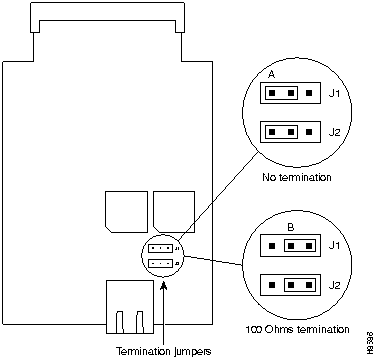
![]()
![]()
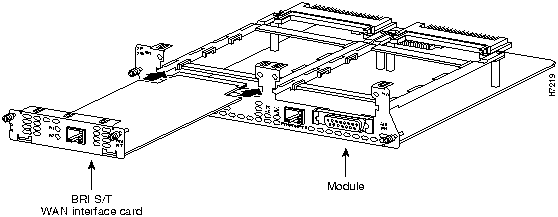
![]()

![]()
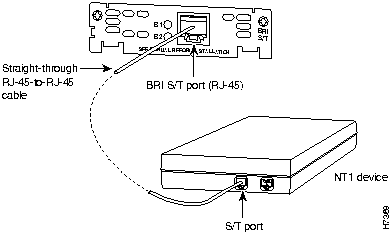
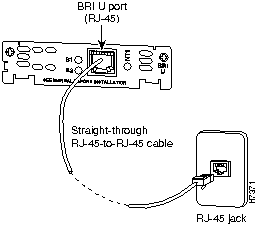
8-Pin1
TE2
NT3
Polarity
3
Transmit
Receive
+
4
Receive
Transmit
+
5
Receive
Transmit
--
6
Transmit
Receive
--
1 Pins 1, 2, 7, and 8 are not used.
2 TE refers to terminal terminating layer 1 aspects of TE1, TA, and NT2 functional groups.
3 NT refers to network terminating layer 1 aspects of NT1 and NT2 functional groups.
LED
Meaning
B1
Call active on B1 channel
B2
Call active on B2 channel
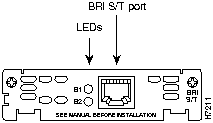
LED
Meaning
B1
Activity on B1 channel
B2
Activity on B2 channel
NT1
Synchronous status of NT1
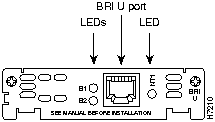
![]()
Country
ISDN Switch Type
Description
Australia
basic-ts013
Australian TS013 switches
Europe
basic-1tr6
German 1TR6 ISDN switches
basic-nwnet3
Norwegian NET3 ISDN switches (phase 1)
basic-net3
NET3 ISDN switches (UK and others)
basic-net5
NET5 switches (UK and Europe)
vn2
French VN2 ISDN switches
vn3
French VN3 ISDN switches
Japan
ntt
Japanese NTT ISDN switches
New Zealand
basic-nznet3
New Zealand NET3 switches
North America
basic-5ess
AT&T basic rate switches
basic-dms100
NT DMS-100 basic rate switches
basic-ni1
National ISDN-1 switches
Would you like to enter the initial dialog? [yes]:
If the current configuration is valid, you enter the normal operating mode automatically.
Router>
enable
Password:
Router#
Router#
config terminal
Router(config)#
isdn switch-type basic-5ess
Router(config)#
ip routing
Router(config)#
appletalk routing
Router(config)#
ipx routing
Router(config)#
interface bri 0/0
Router(config-if)#
Router(config-if)#
ip address 172.16.74.2 255.255.255.0
Router(config-if)#
appletalk static cable-range 5-5
Router(config-if)#
appletalk zone ZZBRI
Router(config-if)#
ipx network B004
Router(config)#
memory-size iomem 40
For further information about the memory-size iomem command, refer to the Cisco IOS configuration guides and command references.
Router#
show running-config
Router#
show startup-config
Router#
copy running-config startup-config
Building configuration. . .
[OK]
Router#
Router#
copy running-config startup-config
Building configuration. . .
[OK]
Router#
This step saves the configuration settings that the AutoInstall process created. If you do not do this, your new configuration will be lost the next time you boot the router.
Would you like to enter the initial dialog? [yes]:
You can enter the System Configuration Dialog at any time from the enable prompt (Router#) by entering the setup command.
First, would you like to see the current interface summary? [yes]:
Interface IP-Address OK? Method Status Protocol
BRI0/0 unassigned NO unset up up
Enter ISDN BRI Switch Type [none]:
Configuring interface BRI0/0:
Is this interface in use? [yes]
Configure IP on this interface? [yes]
IP address for this interface:
172.16.74.2
Number of bits in subnet field [0]:
8
Class B network is 172.16.0.0, 8 subnet bits; mask is
255.255.255.0
Configure AppleTalk on this interface? [no]:
yes
Extended AppleTalk network? [no]:
yes
AppleTalk starting cable range [0]:
5
AppleTalk ending cable range [1]:
5
AppleTalk zone name [myzone]: ZZBRI
AppleTalk additional zone name:
Configure IPX on this interface? [no]:
yes
IPX network number [1]:
B004
Use this configuration? [yes/no]:
yes
Building configuration...
Use the enabled mode 'configure' command to modify this configuration.
Press RETURN to get started!

![]()
![]()
![]()
![]()
![]()
![]()
![]()
![]()